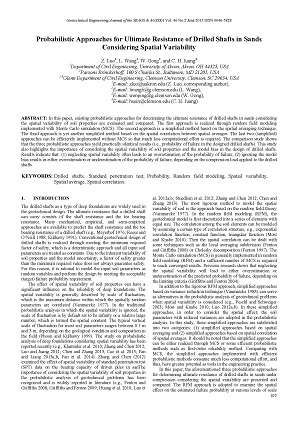Geotechnical Engineering Journal of the SEAGS & AGSSEA ISSN 0046-5828
Vol. 46 No.2 June 2015
Probabilistic Approaches for Ultimate Resistance of Drilled Shafts in Sands Considering Spatial Variability
Z. Luo, L. Wang, W. Gong, and C. Hsein Juang
ABSTRACT: In this paper, existing probabilistic approaches for determining the ultimate resistance of drilled shafts in sands considering the spatial variability of soil properties are evaluated and compared. The first approach is realized through random field modeling implemented with Monte Carlo simulation (MCS). The second approach is a simplified method based on the spatial averaging technique. The third approach is yet another simplified method based on the spatial correlation between spatial averages. The last two (simplified) approaches can be efficiently implemented without MCS so that much less computational effort is required. The comparison study shows that the three probabilistic approaches yield practically identical results (i.e., probability of failure in the designed drilled shafts). This study also highlights the importance of considering the spatial variability of soil properties and the model bias in the design of drilled shafts. Results indicate that: (1) neglecting spatial variability often leads to an overestimation of the probability of failure; (2) ignoring the model bias results in either overestimation or underestimation of the probability of failure, depending on the compression load applied to the drilled shafts.
KEYWORDS: Drilled shafts, Standard penetration test, Probability, Random field modeling, Spatial variability, Spatial average, Spatial correlation.





































